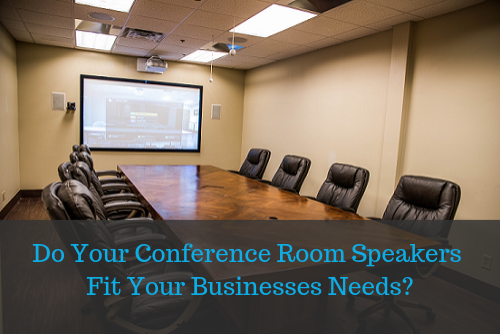Conference room speakers: Bringing the sound
Clear audio is essential to engaging an audience, and conference room speakers deliver that audio to everyone in attendance. Most people underestimate how difficult it is to get sound from one end of a meeting room to the other, clearly and concisely. Poor acoustics, ambient noise and an unfocused presenter can all adversely affect sound quality, but with the addition of conference room speakers, it is much easier to resolve these issues and improve the meeting experience.How A/V integrators utilize conference room speakers
Conference room speakers are essential in maintaining audio quality and ensuring everyone in the room remains engaged and part of the presentation. How those speakers are placed will determine how easy it is for people to hear the presenter. Audio is often the forgotten element when putting a meeting space together, but audio quality has a major impact on a presentation’s effectiveness. Even if a conference room appears small enough to go without audio enhancement, that’s often not the case. This is because sound is readily interfered with by ambient noise, the room’s acoustics, and by the presenter. Sound follows the inverse-square law, which means that doubling the distance the sound has to travel reduces its loudness by a factor of four. Audio quality, then, drops off rapidly, even from one end of the conference table to the other. Here’s how A/V integrators address those issues and match a conference room with the perfect set of speakers:1. Small conference rooms – Many companies are waking up to the benefits of setting up collaborative spaces for their employees. Small meeting rooms, like huddle rooms, are the next step in promoting teamwork, allowing a few employees to quickly secure a collaborative space for their own projects.
Huddle rooms and other small conference spaces usually don’t require audio enhancement to function optimally. In these rooms, everyone can usually be heard with ease. However, in a small conference room, speakers may prove useful for audio masking. Audio masking is much like creating a sound boundary between the meeting space and the rest of the building. Ideally, the conversation inside the meeting room stays in the meeting room, and audio masking makes this possible. A/V integrators are experienced at setting up audio masking systems, configuring them so they aren’t distracting to anyone nearby, while also providing the secure environment that people prefer to work in.
2. Large conference rooms and boardrooms – In general, when A/V integrators consider audio enhancement, they are working in a larger space. Any large conference room will require speakers to ensure even dispersion of audio in the space. This is true even during videoconferencing, where the display has onboard speakers. These audio outputs rarely have the power to project audio to the far side of the room, and when they do have the power, the volume will frequently be too much for people right in front of the display.
The only way around this issue is with a set of conference room speakers, ideally positioned around the space for maximum comfort and even dispersion. It’s not as easy as just installing a bank of speakers, though, as the room’s acoustics will affect how the audio is received by meeting attendees. That’s why reputable A/V integrators first diagram the space’s acoustics, measuring how the sound travels through the room and how it sounds when it hits the ear. Of course, experienced integrators typically know what audio solution will work best in a given environment, but acoustic diagramming helps quantify it.
Once the room’s acoustics are taken into account, it’s time to match the conference room with the right speakers. There are a few options available to the integrator, including front-mounted, wall-mounted and ceiling speakers. Front-mounted speakers are a popular option for many training spaces, especially if the space is organized so that no one is too close to the audio outputs. A lot of training rooms organize trainees into a U-shape, and this works well with front-mounted speakers.
Wall-mounted speakers can create the same kind of multichannel audio that is popular in home and professional surround sound systems. These conference room speakers are an ideal fit in many settings because they promote even audio that is never too loud, even on the far side of the room. However, wall-mounted speakers may not be appropriate in spaces where the ceilings are low, as they may violate ADA regulations.
Ceiling conference room speakers are an all-round option that can work in many environments. They are a compelling choice when the room’s aesthetics must be preserved, as the speakers are mounted inside the ceiling and out of sight. Even from this position, though, the system can create crisp, clear and even audio.
3. Even larger conference rooms – Some meeting spaces look more like a lecture or town hall space, capable of seating a couple hundred people. In expansive spaces like these, audio output placement is even more important. What’s also more important is acoustic diagramming, as a lot can go wrong sound-wise in such a large space.
In a very large conference room, ceiling speakers and wall-mounted speakers may be used in conjunction to fill the space with enough sound. Extra care must be taken to ensure no spot receives too much audio, though A/V integrators can configure speaker systems to avoid this issue. Audio lifting may also be required in these rooms, to help the presenter project their voice clearly.
Conference room speakers ensure nothing goes unheard, and that ensures everyone walks away from the meeting on the same page. Fortunately, A/V integrators have plenty of system options available to their clients, guaranteeing the perfect functional and aesthetic fit for any sized room.


